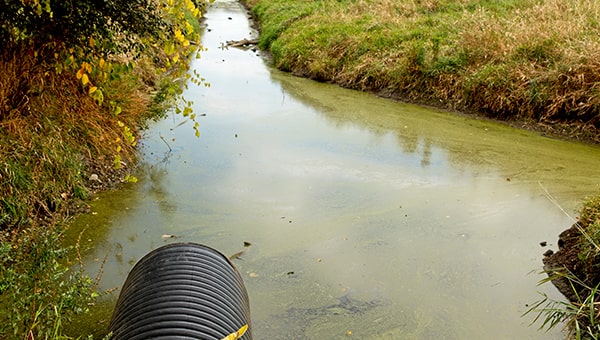Nutrient Neutrality: Frequently Asked Questions
What is Nutrient Neutrality? How is it affecting housing developments? What help and support is available? Find out the answers to these questions and many more right here.

Nutrient neutrality is quickly becoming a hot topic in the construction industry, but it can be difficult to find the answers you need all in one place. For that reason, we've put together this handy FAQ article to answer the most common questions we’re seeing people ask.
General Nutrient Neutrality FAQs
Commonly asked questions about nutrient neutrality.
What is Nutrient Neutrality?
Nutrient neutrality is a restriction being imposed upon any land use or development that will increase nutrient levels in vulnerable watercourses throughout the UK. Where protected sites are in “unfavourable” conditions, any discharge of nutrients must be offset through suitable mitigation measures to avoid any increase to the overall nutrient levels in the area.
Does nutrient neutrality affect both surface water and wastewater drainage?
Yes. Since wastewater and surface water drains typically discharge into the mains system, the nutrient impact of both needs to be considered for areas affected by nutrient neutrality. The same goes for off-mains systems that use domestic sewage treatment plants or septic tanks, as they can discharge into the ground or directly into rivers and streams.
Isn’t wastewater treated before being discharged into a watercourse?
Yes, either by your off-mains sewage treatment plant/septic drainage field or though the large treatment facilities that the mains sewers drain into, wastewater is treated before being discharged into the environment. However, that treatment only reduces certain nutrients to “safe levels”, it doesn’t stop them entering the waterways all together.
How can nutrients harm the environment?
Nutrients such as nitrogen and phosphorus, at post treatment levels, aren’t particularly harmful themselves. However, the artificial enrichment of water through an excess supply of nutrients (also known as eutrophication) can cause an imbalance in the ecosystem with increased phytoplankton productivity. This in turn can lead to unnaturally large blooms of certain algies that can decrease the amount of oxygen in the water and ultimately lead to water intoxication and decreased biodiversity, i.e., it kills off fish and other wildlife.
Why is Nutrient Neutrality suddenly such a big deal?
Nutrient neutrality is becoming a big issue because our waterways are reaching a level of pollution that requires immediate action if we ever hope to repair the damage. Achieving, and then maintaining, nutrient neutrality is the last line of defence for some of the UK’s freshwater habitats and estuaries.
Unless urgent action is taken now to prevent further water pollution, many freshwater habitats and estuaries, especially in Special Areas of Conservation (SAC), Special Protection Areas (SPA), and Ramsar sites, could soon be on the brink of collapse.
Is Nutrient Neutrality not already covered in a Habitats Regulations Assessment?
Technically, yes, but the conditions have changed. The need for a Habitats Regulations Assessment to be performed, to prove a development or change in land use will not negatively impact the environment in protected areas, is nothing new, and the concept of nutrient neutrality has been around since 2019.
However, prior to the latest guidance issued by Natural England, in March 22, the assessment only focused on the amount of nitrogen entering protected waterways. Current advice has also brought in phosphorus levels as a point of concern that needs to be addressed.
What does the Natural England advice mean?
The advice given to Local Planning Authorities (LPAs) in areas with protected sites by Natural England’s stated that planning permission in these areas should only be granted if it can be proven the development or land use will not cause an increase in nutrient pollution - specifically, an increase in nitrogen and phosphorus levels.
Originally, this advice was given to 32 LPAs, those with protected waterways in the least favourable conditions. In March 2022, however, a further 42 LPAs have been given the same advice, suggesting that our water pollution problem is still heading in the wrong direction and much more needs to be done to avoid disaster.
How can Nutrient Neutrality be achieved?
Achieving nutrient neutrality is all about balance. Essentially, there is a finite amount of nutrients that can exist in protected watercourses to prevent them becoming polluted (or help reverse the current levels of pollution, as is the case for some). If you want to build a house that will add 5 mg/l of phosphorus into one, the only way the LPA can now grant you planning permission is if you can show that an equal amount of phosphorus will be removed from the same waterway to offset it and maintain a neutral balance - nutrient neutrality. For a development to be deemed “acceptable”, it will need to be supported by a Habitats Regulations Assessment (HRA) that either demonstrates how the site will avoid causing additional nutrient pollution or shows a suitable mitigation strategy that will balance out its nutrient production if not.
See the Mitigation section below for advice on possible solutions.
How long will the nutrient neutrality restrictions be around for?
Nutrient neutrality restrictions are likely to be in place for the foreseeable future. The reports from Natural England paint a worrying picture about the current state of our waterways, and more and more LPA’s are being advised to add nutrient neutrality to their conditions for planning approval. This suggests that things are likely to get worse before they get any better, both for the environment and housing developments etc.
What areas of the country are affected by Nutrient Neutrality?
Currently, 74 councils have nutrient neutrality catchment areas within their jurisdiction. The Planning Advisory Service has created a helpful map that shows the areas affected, and a full list of the 74 councils can be found in an article by Housing Today.
Nutrient Neutrality and Planning Permission FAQs
Commonly asked questions about how nutrient neutrality affects planning permission applications and approvals.
How will nutrient neutrality affect planning permission applications?
Nutrient neutrality restrictions in the catchment areas identified by Natural England are causing substantial delays in the approval process for planning permission applications. Many of the affected Local Planning Authorities, especially those that only received notice from Natural England in March 2022, have temporarily suspended the approval of any applications until proper plans and systems can be put in place to accommodate the new guidance.
Will nutrient neutrality affect plans that have already been submitted?
If an application for planning permission is currently under review but does not show evidence of how nutrient neutrality can be achieved for both nitrogen and phosphorus, it is highly likely to be rejected or at least delayed until such evidence can be provided. Any plans, policies or supplementary planning documents you already have in place may need updating to reflect the latest advice and calculation methods from Natural England for both the impact of excess nitrates and phosphates from your development.
What help is available for plans already at an advanced stage?
Local councils and planning authorities will usually write out to anyone affected by the nutrient neutrality situation to advise what it means for their applications and what their options are. Most councils in the catchment areas highlighted by Natural England also have a lot of helpful information up on their websites, often including handy calculators to assist in working out the potential impact on your development.
How should you account for nutrient neutrality in your planning applications?
When submitting a planning application in a nutrient-neutral area, you must be able to prove to a Habitats Regulations Assessment (HRA) that your development will not ultimately increase the level of nutrients in the environment. To achieve this, you will need to show the project nutrient burden of your development along with sufficient mitigation methods to balance it out. For more information about how your application will be assessed, check out the Habitats Regulations Assessment guidance on the government's website.
How do you calculate the nutrient burden of your development?
Natural England has produced a four stage methodology to help developers calculate a nutrient budget for their project. Basically, it requires you to calculate the potential nutrient levels of your development, the existing nutrient levels from the current land use, the nutrient levels from future use of the land and then work out the total change in nutrient levels that the development will cause, including a 20% “uncertainties” buffer. Below is a more detailed summary of each step:
Stage 1 - Calculating the nutrient increase from the development.
- Step 1 - calculate the proposed increase in population from the development (number of dwellings x residents per dwelling).
- Step 2 - multiply it by the potential increase in wastewater production (additional population x daily per person water usage).
- Step 3 - deduct the acceptable nutrient loading value to account for wastewater passing through treatment plants/facilities.
- Step 4 - combining Step 2 & Step 3 to calculate the additional nutrient load that will discharge into the Habitats site.
Stage 2 - Calculating the current nutrient load
- Step 1 - obtain the annual nutrient export values of the current (pre-development) land use(s).
- Step 2 - multiply the figures obtained in Step 1 by the area of land to calculate the current nutrient load.
Stage 3 - Calculate the nutrient load from future land use
- Step 1 - account for the nutrient export from non-built land on the development site (public green spaces etc.) using the relevant export coefficients (determined in Stage 2) multiplied by the area of land.
Stage 4 - Calculate the nutrient budget
- Step 1 - using the final figures from each of the previous stages, calculate the nutrient budget of the development (Stage 1 - Stage 2 + Stage 3).
- Step 2 - add a 20% buffer to the result of Step 1 to account for residual uncertainties in the methods used above.
How will this new restriction affect the Government's housing promises?
In 2019, the Conservative manifesto set a target of 300,000 new homes being built every year by the mid-2020s. With recent research by the Home Builders Federation claiming that around 120,000 homes are now being delayed or blocked by the nutrient neutrality issue, it is almost certainly going to make it harder to achieve that target. Whether this ultimately puts pressure on councils to allow housing developments in less suitable or desirable areas, potentially opening areas up to speculative development, will largely depend on how long it takes for long-term mitigation solutions to arrive.
Will Nutrient Neutrality affect Five Year Housing Land Supply?
Nutrient Neutrality restrictions are likely to have a big impact on any affected council’s five year housing land supply plans, as areas that would have previously been designated for housing developments may now no longer be viable. However, in May 2022, the government did indicate that future planning reforms may exempt councils from needing to show a five year housing land supply, in order to fend off speculative developments, as long as their plans are up to date. Such reforms could grant councils some breathing room to either develop suitable mitigation strategies for the affected locations, or find new sites outside of the catchment areas.
What is the Government doing to support local authorities dealing with nutrient neutrality catchment areas?
Through its Department for Levelling Up, Housing and Communities (DLUHC), the government is said to be “actively considering” ways to deal with the difficulties surrounding housing developments and the nutrient neutrality issue. Funding support, amounting to £100,000 for each catchment area, is being made available for affected councils and LPAs. This is intended to help them invest in the resources and expertise needed to develop solutions and put in place the infrastructure required to process all the planning applications that will be impacted by nutrient neutrality.
Will there be a transition period for areas that fall within the new nutrient neutrality boundary lines?
Transition periods to phase in nutrient neutrality in newly defined catchment areas will not be possible. This is due to the fact that the nutrient pollution risk is much higher from developments in areas that have not previously had to apply the nutrient neutrality restrictions.
For existing catchments, however, where the original nutrient neutrality guidance is already being followed, Natural England has advised that it would be reasonable to allow for a transitional upgrade to measuring planning applications already in progress against the new calculation methods.
Will Natural England be providing advice and support to Local Planning Authorities?
Natural England has already made available its recommended methodology and calculator tools for anyone that needs them, and can be consulted when Habitats Regulations Assessments and Appropriate Assessments are produced. However, they have also made it clear that it will be the responsibility of the “competent authority” (LPA, Council, etc.) to decide whether a development or project will have a negative impact on a protected environment.
Will Natural England provide advice and support to applicants and agents on Nutrient Neutrality?
Beyond the advice and tools already provided to LPAs, it is unlikely that Natural England will be offering advice on specific cases going forward. The responsibility for helping applicants with their planning permission requests lies with the competent authority in charge of the relevant catchment area.
Nutrient Neutrality and Development Management FAQs
Commonly asked questions about how nutrient neutrality affects development management.
What types of development are affected by Nutrient Neutrality?
The advice from Natural England technically applies to any and all land usage or development that can cause nutrient pollution - housing, commercial, tourism, and agricultural developments can all be affected. However, its particular focus is on developments that will result in more overnight stays in the area. This is because an increase in overnight stays is guaranteed to generate additional wastewater, which in turn means an increase in nutrients entering the waterways.
How does Nutrient Neutrality affect Housing developments?
The guidance from Natural England suggests that Local Planning Authorities calculate the nutrient neutrality impact of new housing developments based on the net increase in the number of dwellings it will bring to the catchment area. The advice suggests using an average occupancy figure in the nutrient budget calculations, but LPAs are free to choose other methods.
Despite claims from the Home Builders Federation that “nutrients from the urban environment contribute around just 4% of the problem”, housing developments seem to be bearing the brunt of the restrictions. Until councils and LPAs get caught up with the methodologies and update their approval processes, planning permission for houses in the catchment areas defined by NE are likely to experience significant delays and/or require completely resubmitting along with new proposals on how they can achieve nutrient neutrality.
More information on possible mitigation strategies can be found below, but they all come with an additional cost. The Home Builders Federation estimates that current mitigation methods will cost developers approximately £5,000 per house to offset the increased nutrient loads produced, which could ultimately have a serious impact on the viability of a development.
Will Nutrient Neutrality affect planning permission for house extensions?
This will depend on the calculation method used by the Local Planning Authority. If they calculate the nutrient budget of a dwelling based on average occupancy, and the extension isn’t intended to increase the number of people living in the property, the planning for it may be exempt. However, if the LPA chooses to calculate the nutrient budget on a per bedroom basis, and the extension in question will add more bedrooms to the property, it may then be impacted by nutrient neutrality restrictions. Check with your local council or planning authority before making any plans, just to be safe.
How does Nutrient Neutrality affect Commercial developments?
In theory, the majority of commercial developments requiring planning permission in a catchment area (such as retail establishments, schools, and hospitals) could be exempt from the nutrient neutrality restrictions. This is because it is largely accepted that people tend to live and work in the same area and, therefore, the nutrient load from the people working in the commercial developments would be accounted for by new housing mitigation.
In practice, however, it will be up to the Local Planning Authority to decide if an exemption is warranted. While the future use of the property may not impact the nutrient balance in the area, the construction of it still could, through surface water run-off etc., meaning a Habitats Regulations Assessment could still be required. The same will be true if the development is likely to attract more people for employment, or as visitors, to the catchment area. If unsure, LPAs will need to discuss such projects with Natural England to clarify if Nutrient Neutrality is needed, which could further extend delays in the approvals process.
How does Nutrient Neutrality affect Tourism developments?
Tourist attractions and accommodation will all be affected by nutrient neutrality. Even if the development is only intended to draw day visitors, toilet facilities will be required which will then increase the wastewater being produced in the area. Since it would be highly likely that most of the long term tourism draw will be for people travelling from outside the catchment area, this would then fall within the scope of the Nutrient Neutrality restrictions.
It will be up to Local Planning Authorities to review all applications on a case by case basis, however, as there is currently no “one-size-fits-all” solution.
How does Nutrient Neutrality affect Agricultural development?
Agricultural land use accounts for a large proportion of nutrient pollution, generally through surface water run-off into rivers and streams. Pig farming, for example, can have a nitrogen leaching rate of around 500 kg/ha/yr, compared to residential land that can have a rate of around 70 kg/ha/yr. Agricultural developments will therefore need to be reviewed carefully on a case-by-case basis by Local Planning Authorities. However, agricultural land use in catchment areas also offers one of the simplest mitigation strategies for other developments to benefit from. See section below on nutrient credit strategies.
How do you know if a development will be affected by nutrient neutrality?
The first step in determining if a development will be affected by nutrient neutrality is to check if the site falls within the catchment areas set out by Natural England - the Planning Advisory Service offers a useful map to help with this, or you can check those being provided by affected local councils. The next step will then be to contact your Local Planning Authority for further advice.
It is worth noting that, while a development may fall outside of a catchment area, the treatment facility that will receive wastewater from the site may be located within one. If so, nutrients from the development would still make it into the protected watercourses and, therefore, it would still fall under the nutrient neutrality restrictions. It will ultimately be up to the LPA to decide whether a development will or will not require consideration under the nutrient neutrality guidance, but developers can help speed up the process by doing their research and preempting any need for mitigation plans to be put in place.
Are there any conditions under which Local Planning Authorities can ignore the nutrient neutrality guidance?
Theoretically, as competent authorities under the Habitats Regulations, Local Planning Authorities could simply ignore the advice given by Natural England altogether and just continue issuing planning permission within the catchment areas. However, in the vast majority of cases, planning permission granted to developments which have not demonstrated that their project will not have a negative impact on the protected environment would be deemed unlawful. This would leave both the development and the decision to grant its permission open to legal challenge. Lawful planning permissions in the catchment areas can only be made after the appropriate assessments have been made and by following the advice given by Natural England.
What if a development inside a nutrient neutrality catchment area discharges its wastewater outside of the boundaries?
If a development site inside a catchment area is served by wastewater treatment works located outside of said area, then the wastewater element of the nutrient budget can be excluded. This will reduce the amount of nutrients needing to be offset, but it will not get rid of them entirely. Surface water drainage, both during and after the construction of the site, must still be accounted for and, as such, the development would still require a Habitats Regulations Assessment.
What if a development is outside of a nutrient neutrality catchment area, but the wastewater from it discharges into one?
If wastewater, or surface water, from any development discharges or drains into a protected watercourse, irrespective of whether the site is located outside of a Natural England catchment area, it will fall under the nutrient neutrality restrictions. Developers must do their due diligence to discover where their wastewater and surface water is going to drain to. Lists of sensitive wastewater treatment works can be found in most nutrient calculators provided by councils and Local Planning Authorities.
Nutrient Neutrality Mitigation FAQs
Commonly asked questions about how nutrient neutrality issues can be mitigated.
What does nutrient neutrality mitigation mean?
Nutrient neutrality mitigation refers to the methods in which the nutrient production of a development will be offset to maintain a neutral balance of nutrients in a protected environment. In other words, the way in which you ensure that the same amount of nutrients being added to the environment by your project are removed by some other means to prevent an increase in nutrient pollution. Various on-site and off-site options are being trialled, but they are mostly short term solutions.
What are the on-site solutions to achieving nutrient neutrality?
On-site nutrient neutrality mitigation solutions are broadly aimed at trying to reduce/eliminate the nutrient load produced by a development before it reaches a protected watercourse. Recommendations from Natural England include constructing wetlands and using Sustainable Urban Drainage systems to filter out as many nutrients from the site’s surface water and wastewater as possible.
While installing SUD systems and private sewage treatment plants could be within the scope of many projects, however, having to set aside land on your development site, or purchase extra land, to facilitate the creation of wetlands or fallow land, is likely to be more problematic.
It is possible that future plans being made with nutrient neutrality in mind may be able to achieve it with on-site interceptor spaces placed between the development and the protected watercourse. Existing plans, however, where the land usage has already been fully allocated for the development, may instead have to retrofit SUDs and STPs to reduce the nutrient load as much as possible before then investing in an off-site solution to balance out the rest.
What are the off-site solutions to achieving nutrient neutrality?
Off-site nutrient neutrality mitigation solutions are, in essence, aimed at allowing developers to pay someone else to worry about reducing their nutrient load to offset that of the development. It is the, relatively, quick and dirty option that is, unsurprisingly, becoming the solution of choice for those currently stuck in planning permission hell. This is achieved through nutrient credit trading schemes. Landowners in the same catchment area can change how their land is used (turning farmland into wetlands, for example) to reduce their nutrient load and create a bank of nutrient credits that can be bought by developers to offset their nutrient load.
The problem with this solution, aside from it being costly, is that it doesn’t really address the levels of nutrient pollution being caused by developments. In the short term, this isn’t likely to be an issue. In the long term, however, given Natural England’s advice that any mitigation land should be maintained for 80-125 years, this “pass-the-book” solution isn’t really ideal. If farming land has to be consumed to allow for the environmental costs of other developments everywhere that nutrient neutrality becomes an issue, it could have a lasting impact on the country’s food production capacity.
What would be the cost of buying nutrient credits?
It may be tempting to simply rid yourself of some of the headaches by buying into a nutrient trading scheme, especially if you have already purchased the land for your development and don’t realistically have the scope to accommodate the sizable interceptor zone that would be required to achieve nutrient neutrality. However, this will still put a heavy financial burden on your development. As a rough example, a single 4-bed house will likely require 3.285 credits per year to balance out its nutrient production. At £3000 per credit, that’s almost £10,000 a year needed to offset that one property.
Could developments be charged an “environmental tax” to fund mitigation solutions in other parts of the country without then having to change their plans?
Many Local Planning Authorities are already considering/implementing their own version of a nutrient neutrality credit scheme to provide developers with an off-site mitigation solution, which will essentially then be an environmental tax, albeit an optional one. The main condition of any offset solution, however, is that it must balance out the nutrients within the same catchment area. When the whole point of nutrient neutrality is to reduce the nutrient pollution levels in protected areas, it would serve no purpose whatsoever to have mitigation wetlands created outside of the catchment area in which the development is planned.
Have any nutrient neutrality mitigation strategies been successful so far?
There are many strategies and schemes currently being trialled across the UK, such as Community Infrastructure Levy (CIL) money being used in Wiltshire to deliver temporary mitigation, and a nature reserve in the Solent being used to offset nutrient loads through a nitrate trading auction platform. Success, in terms of how they are helping planning permission approvals, seems slow but positive. Success, in terms of having a positive impact on the nutrient pollution levels in the affected areas, is possibly too soon to say. With more and more catchment areas being designated by Natural England, however, it would suggest that there is more that needs to be done.
Shouldn’t nutrient neutrality mitigation be a problem for the water companies rather than housing developers?
According to the Home Builders Federation, the vast majority of nutrients in the rivers is coming from “agriculture or failings of the water companies”. In light of this, it would seem only fair that more of the nutrient neutrality burden should fall upon them rather than the housing industry. However, upgrading existing wastewater treatment facilities and drainage networks isn’t going to happen overnight. While competent authorities should certainly be reviewing their discharge permits and putting pressure on the water companies to do their part, the quickest way to make an impact on nutrient pollution right now is to ensure that new developments aren’t going to be adding to the existing problem.
And that's it for this nutrient neutrality FAQ. Hopefully, we have been able to answer most of the questions you had. For a more general overview of the issue, check out our “What is Nutrient Neutrality, and why should you care about it?” article or, if you would like to discuss how nutrient neutrality is affecting your project with one of our experts, call our Technical Support team on 01228 794445 and ask for Tom House or Jake Holden.







